Suit of Swords (Behind the Scenes)
[To search page, please use CTRL+F or equivalent function on mobile browsers, like "Find on Page"]

Ace of Swords (Eggman Nega)
For the Ace of Pentacles, I decided to use Eggman Nega. This card is very Eggman-coded to me, and Nega exaggerates his ancestor's traits in a way that fits the Ace of Pentacles’ intellect and savagery even better. Nega highlights the negative aspects of wit through his constant manipulation of both strings and people, and the reversed Ace of Pentacles, but his fierce temper makes him make mistakes the original Eggman would never stoop to. For the art, I toyed with including the Jeweled Scepter in Nega’s hand, but I decided that having him point to his primary asset in battle—his brain—would fit the card better. He is also facing away from the viewer to show his disregard for other people's opinions.
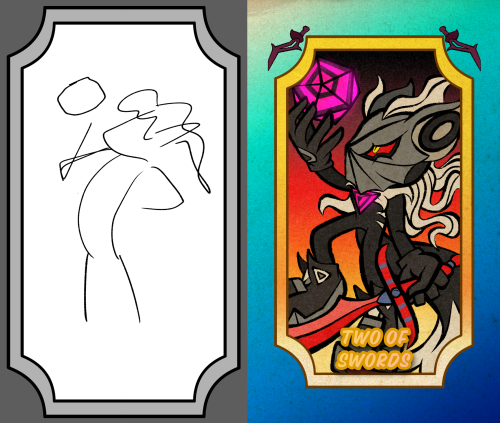
Two of Swords (Infinite)
For the Two of Swords, Infinite felt like the right choice given his character arc. His aim to overcome that which paralyzes him is a noble one, but as a parallel character to the Avatar, his take on that journey is corrupted due to his megalomaniacal tendencies. But his avoidance of past failures turns into disregard for potential future ones in Two of Swords reversed, as not taking the Avatar seriously is what ultimately foils his plans and defeats him for good. I wanted to highlight the Two of Swords’ dual paths in the art, so I made the object Infinite looks at the Phantom Ruby, which is integral during the War to Take Back the Planet. Meanwhile, his other hand holds the sword he wielded as part of the Jackal Squad to represent the past he yearns to avoid yet learns very little from.
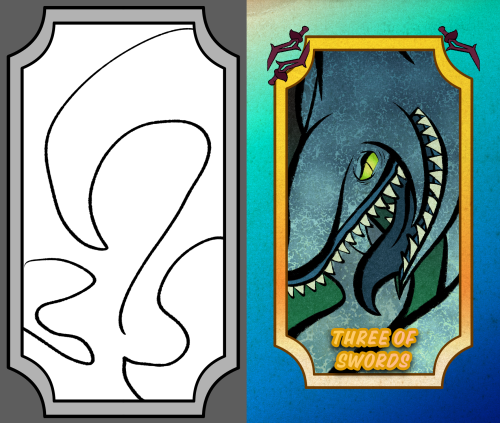
Three of Swords (Chaos)
For the Three of Swords, which is a rather melancholy card, I felt that Chaos was the best fit. Chaos is not really evil or inherently malicious, with his actions stemming from trauma aimed toward him and the other Chao. Understandably, the Knuckles Tribe’s violent aims for the Master and Chaos Emeralds would cause anyone to be wary of outsiders and their intentions, with Eggman’s ignorance of Chaos’ past contributing to losing control over the creature. But the conclusion of SA1 sees Chaos release his pain and move on from the past, in line with the Three of Swords’ reversed meaning. Perfect Chaos ended up being the form of Chaos I decided to depict on the card; the design is more inspired by how he looks in SA1 over his Sonic Generations redesign (I don’t like the dark blue armor bits of the latter very much). His expression seems intimidating on first viewing, but I hope that a tinge of his pain can be visible, as well.
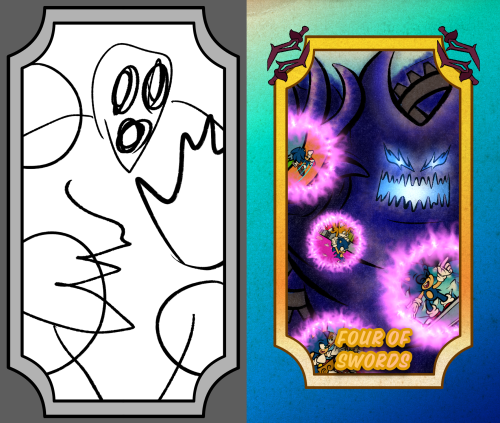
Four of Swords (Time Eater)
For the Four of Swords, the Time Eater might seem like a bizarre pick. However, due to the malevolent goals of the Eggmen controlling it, the Time Eater’s distortions isolate and trap all the characters targeted by it in a limbo state, unable to move and with nothing but their thoughts to keep them company. The Sonics, on the other hand, do learn to proceed through this problem by analyzing their past experiences. The Four of Swords reversed is a bit more positive, with its themes of healing and restoration fitting the aftermath of the Time Eater’s defeat rather well. I thought it would be fun to have the time portals the Time Eater has opened to feature scenes from the Cups suit, with different locations Sonic has visited in the past. It might even help the viewer to contemplate their own past!
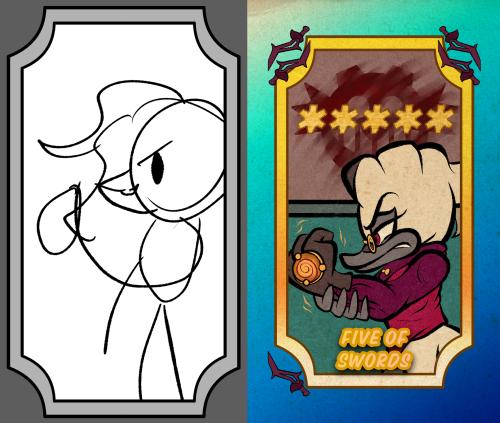
Five of Swords (Dr. Starline)
For the Five of Swords, I wanted to feature the first IDW character appearing in SONIC THE TAROT: Starline. I am personally a sucker for when any Eggman parallel or assistant is added to the franchise, and I feel like Starline simultaneously having more flair and less aversion to outright violence gives him some elements of the Five of Swords. Also, his bitter ex-behavior after being kicked to the curb by Eggman gives him a determined edge that sees him want to “win” over his former idol at all costs. Of course, his final defeat showcases the card’s reversed meaning, as well: Starline’s sense of superiority over everything leads him to not consider outcomes in which he loses—or if his opponent is more clever than he is. I will admit I got a little anachronistic with the art for this card, as I chose to depict Starline’s more bitter feelings toward Eggman while still giving him the Warp Topaz. I feel like the Warp Topaz is the more iconic of Starline’s two glove cores and was a contributing factor to Eggman and Starline’s split. Ultimately, I decided to feature Warp Topaz for symbolism’s sake even if the inspiration scene of this card—from issue 31—was a bit after the stone itself was taken from Starline.
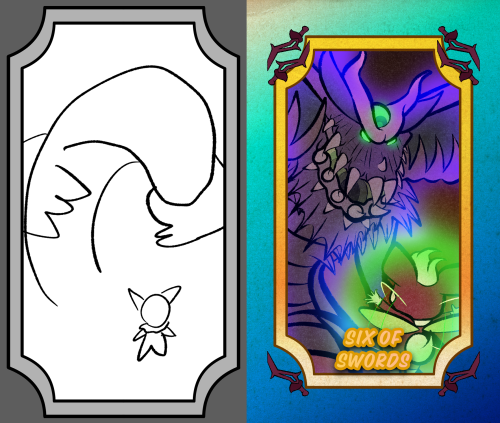
Six of Swords (Dark Gaia)
For the Six of Swords, Dark Gaia (and by association Light Gaia) fit the themes of transition and cycles the best. I would argue that the Dark Gaia is not “evil” per se, simply a necessary part of death and rebirth for the planet. Dark and Light Gaia had participated in this cycle for eons, and it only became a problem during the plot of Unleashed because Eggman forcibly started the process early. Thus, the volatility seen in the Six of Swords reversed is most visible in Dark Gaia’s inability to be constrained and controlled, with its early awakening disrupting all of life and death as we know it. The art for this card is pretty straightforward, depicting Dark Gaia and Light Gaia standing off at the end of Unleashed—I wanted to include Chip because I don’t think either Gaia is complete without the other’s presence.
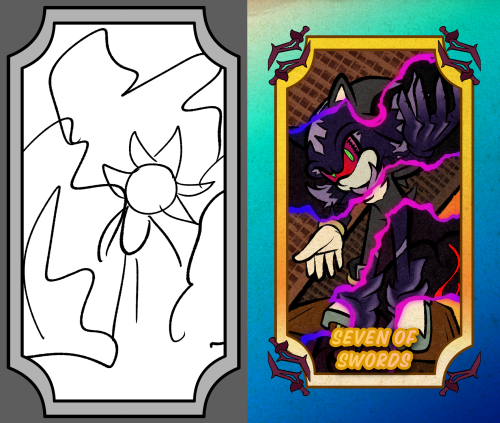
Seven of Swords (Mephiles the Dark)
For the Seven of Swords, no antagonist in the Sonic franchise fits better than Mephiles. Mephiles holds the distinction of being viewed as a (albeit menacing) ally by the heroes, with Silver and Blaze’s quest starting through his machinations. In general, Mephiles favors manipulation as his method of getting things done, only really attacking outright during certain parts of Sonic ‘06. But I was really excited for this card once Shadow Generations came out, as I feel like the reversed meaning of Seven of Swords became even stronger. Mephiles’ denial of his limbo existence in time-space adds a compelling edge to his character, especially given that Shadow has no idea who the hell he is while he’s having this breakdown. I did a divided composition for this art over the original thumbnail to highlight Mephiles’ duplicitous nature: his Shadow form being from when he first meets Silver and Blaze, and his Crystal form from when he fights Shadow.
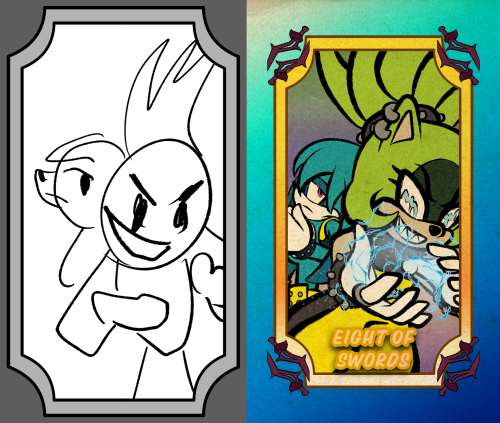
Eight of Swords (Surge the Tenrec and Kit the Fennec)
For the Eight of Swords, the themes of victimization and oppression applied best to Surge and Kit. They were literally under the control of Starline up until his death, being the only ones who knew who they used to be and being responsible for brainwashing them in the first place. I especially like Surge and Kit’s dynamic for how they process their trauma, with Surge lashing out at Kit and Kit just becoming more codependent on Surge. It’s a significantly less pretty partnership for this series, and the change is very refreshing, especially seeing how they cope and recover from it when the card is reversed. It’s cute when they realize that they can be heroes after saving the tram, even if not everyone appreciates their efforts and they’re still motivated by beating Sonic. I had Surge in the foreground of this card and Kit in the background to reflect their dynamics and personalities along with their expressions.
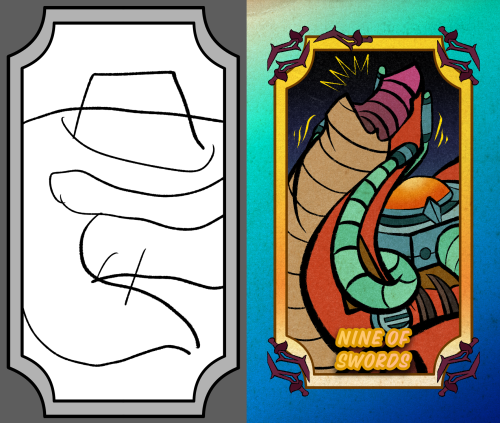
Nine of Swords (Biolizard)
For the Nine of Swords, another painful-themed Swords card, I selected the Biolizard. Outside of when it was very little, the Biolizard has been hooked up to life support equipment for all its life because it simply does not have the facilities to sustain itself; during its battle with Shadow, it makes all manner of groaning to even pivot in place. On top of being isolated for half a century, the Biolizard is forced to become the Finalhazard, losing all control of itself to see the Space Colony ARK’s drop through. But as the Nine of Swords reversed shows, Super Sonic and Shadow do free the Biolizard from its pitiful existence, finally allowing it to rest for good. Unlike the static position in the thumbnail, I opted for the Biolizard doing its roar from its battle with Shadow in SA2, because it’s probably equal parts agony as it is rage.
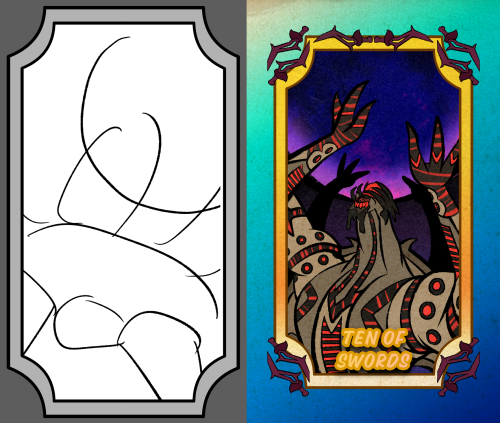
Ten of Swords (THE END)
For the Ten of Swords, what I’d argue is the darkest card in the Minor Arcana (if not the whole deck), I wanted to make sure I represented the gravity of its destructive themes—THE END seemed perfect to me. The Ten of Swords is literally about painful conclusions, and THE END has destroyed countless worlds to return them to the “sanctity” of nothingness. Notably, there is no reversing this damage: Sonic is not capable of bringing the Ancients or any other society back, only to allow their remnants to find peace. Through the reversed Ten of Swords, Sonic and friends defeat THE END and prevent it from consuming the entirety of their world—but can such a being truly be defeated for good? I drew THE END’s moon form as the background focus of the card, with the corrupted Supreme reaching toward it. I intended its many arms to almost look like marionette strings, but I’m not sure how well that was conveyed.
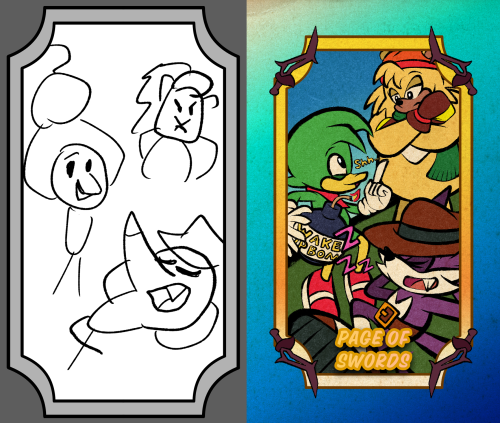
Page of Swords (The Hooligans: Fang the Hunter, Bean the Dynamite, and Bark the Polar Bear)
For the Page of Swords, I struggled a little bit on assignments before settling on the Hooligans. Some of the only redeeming factors of the Hooligans as a collective are their ability to stake our future heists and play off of each other's physical prowess, along with their zany rapport. And they must have had SOME success given their notoriety, right? But I feel like the reversed meaning of the Page of Swords is more prominent here, as Fang is a really bad leader and constantly puts himself above his so-called “mooks.” Honestly, I'm glad that Bean and Bark eventually call it quits and dump his ass lol. I thought making the art a combination of the upright and reversed meanings would be fun: Bean and Bark are alert and the latter’s indifference allows the former to pull his mischievous prank, while Fang is leeching off the others to sleep on the job.
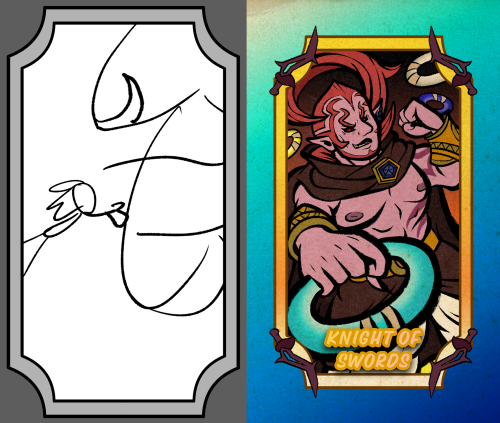
Knight of Swords (Erazor Djinn)
For the Knight of Swords, we have the Secret Rings representative for SONIC THE TAROT in the form of Erazor Djinn. I have a soft spot for the Storybook games and wanted to dedicate a couple of cards to them, but Erazor Djinn is fitting even without my biases. Unlike earlier Modern antagonists like Chaos, the Biolizard, and Dark Gaia, Erazor possesses enough cognizance to showcase a personality outside of mindless rampaging; he is WELL aware that he’s sadistic and has self-motivated ambition for revenge without the prodding of Eggman or another outside source. The ruthlessness of the reversed Knight of Swords is seen through his actions against Sonic; Erazor is one of the few foes that has gotten dangerously close to outright killing Sonic—the Flame of Judgment inflicted upon the latter only went out upon transforming into Darkspine Sonic—and his spiteful personality takes every opportunity to jab at the hedgehog. Erazor’s an arrogant bastard, and seeing him get his comeuppance in the end is very satisfying. This art is a companion piece to Shahra’s Seven of Wands, with Erazor possessing the Yellow, White, Aqua, and Blue World Rings, which he used to transform into Alf Layla wa-Layla. Speaking of Alf Layla wa-Layla, I originally planned on featuring that form of Erazor battling against Darkspine Sonic. However, I decided against it because Alf Layla wa-Layla doesn’t showcase most of Erazor’s relevant traits to this card, and honestly, I didn’t think I should have Sonic on any of the antagonistic Swords cards. Saved me the trouble of figuring out how to draw him!
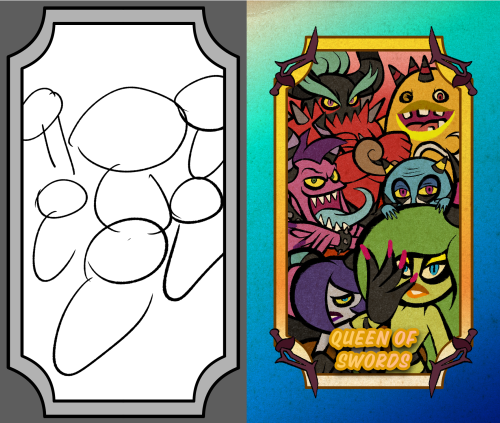
Queen of Swords (The Deadly Six: Zavok, Master Zik, Zazz, Zeena, Zomom, and Zor)
For the Queen of Swords, I ultimately settled on the Deadly Six. Despite their unpopularity within the community, I’d argue they are the best example of a villain team actually functioning alright. They’re all capable in a fight and are—despite what appearances may suggest—sharp enough to trade barbs with Sonic himself. Once freed of the Cacophonic Conch’s influence, the Deadly Six efficiently supplant Eggman as the main threat of Lost World, a role he only regains once Sonic defeats them first. As the reversed Queen of Swords shows, they’re more savage than Eggman as well, even intending to roboticize Tails and almost getting away with it. Roboticization is one of the Archie/SatAM conventions I actually enjoy, and I’m glad to see it in the game canon in SOME fashion, even if they won’t let Eggman have any fun. This card’s art was mostly a feat in trying to cram six characters in a very vertical canvas—my sister had to help me figure out how to fit them all in there, for which I’m very grateful.
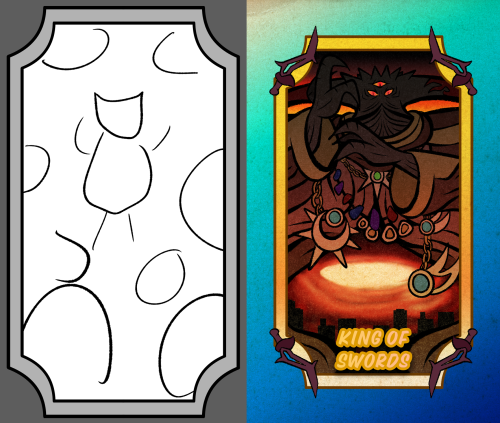
King of Swords (Black Doom)
For the King of Swords, I didn’t consider any choice besides Black Doom. The authority and methodicalness of the card perfectly suit Black Doom: his subordinate Black Arms absolutely litter the stages of Shadow ‘05 and his manipulations of Shadow succeed in numerous routes. Black Doom is even intelligent enough to solve the question of eternal life for Gerald! Of course, his maliciousness is his most prominent trait, with plans to turn humanity into livestock and (during the Time Eater incident) forcibly possess his biological son to resume his omnicidal aims. And as far as we can tell, Black Doom and the Black Arms already left a bloody swath of planets and societies behind them, with Earth just being their new target. For the card, I was originally going to have Black Doom in the black ushering various Black Arms forward to battle. However, I got possessed with the idea of making Black Doom loom over the entire canvas, his robes opening to show the invasion scene from the beginning of the game. In the end, I think this is one of the coolest-looking cards in SONIC THE TAROT, and I hope you agree!













